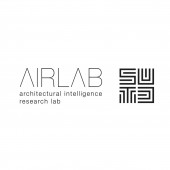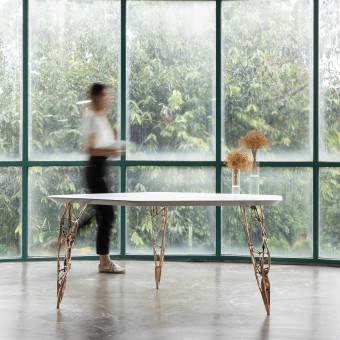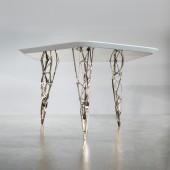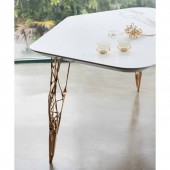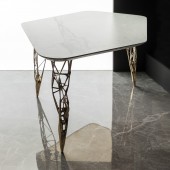DESIGN NAME:
Aitable
PRIMARY FUNCTION:
Furniture
INSPIRATION:
At first glance, they are just a few table legs. The filigree, interwoven structures could be the work of a designer, inspired by observations made during a walk in the forest. To ensure that such fragile-looking structures do not collapse under the weight of a heavy tabletop, however, profound knowledge of the calculation of static loads is required in addition to artistic skill.
UNIQUE PROPERTIES / PROJECT DESCRIPTION:
Standard designs for a table this heavy would require a thick section under the tabletop.
Artificial intelligence presents a powerful tool to search for structurally more efficient design strategies to deliver radically new aesthetics.
Using precise 3DPrinted sand molds, the three unique legs are cast in bronze and manually polished, creating sophisticated reflects of nuanced refections under changing light conditions.
AI Table showcases how digital design can foster creativity and pragmatism.
OPERATION / FLOW / INTERACTION:
This unique fabrication process combines a traditional method such as bronze casting with state-of-the-art 3D Printing moulds. The chosen sand-3DPrinting system is a powder-based process that does not require supports in the build process. On the one hand, this feature eliminates the need for printed (and lost) support structures, and, on the other, almost 100% of the unbound powder can be reused.
PROJECT DURATION AND LOCATION:
1 year
Singapore
|
PRODUCTION / REALIZATION TECHNOLOGY:
PPMA Printed Mold
Cast Bronze
Autodesk Fusion 360
SPECIFICATIONS / TECHNICAL PROPERTIES:
1600 x 1000 x 750 mm
The material of choice turned to bronze. Therefore, a positive model made of polymethyl methacrylate (PMMA for short) was 3D printed, and the models were then transformed into cast parts by the renowned artistic foundry Strassacker, based in Germany
TAGS:
Additive Manufacturing, 3D Printing, Digital Design, Artificial Intelligence
RESEARCH ABSTRACT:
The table is a statement on the redefinition of ornamentation in furniture design. The three bronze legs were designed following an ultra pragmatic process of material reduction with the help of powerful AI algorithms. Consequently, there is no additional layer of decoration. Each ounce of bronze is solely placed with the purpose of increasing the overall structural performance.
The smooth and fluid geometry of the legs and the delicate tabletop provides a rich tactile quality.
CHALLENGE:
The idea behind these branching table legs is not just based on the creative mind of a human being, but also the AI functionality of Autodesk Fusion 360 software combined with powerful 3D printing technology and traditional metal casting.
To cast the parts, the foundry molded the PMMA patterns into a ceramic shell that met the high-precision specifications. And as filigree as the end product may appear, in terms of stability these table legs are fully equal to a solid construction. The difference is made by a significantly reduced material input thanks to AI-assisted design and 3D pattern printing.
With 3D sand printing, formwork skins or entire formworks for concrete casting applications can be 3D printed regardless of their complexity. The printed formwork elements can be post-processed and optimized for ideal surface finish and for resistance to external weather conditions on construction sites, and can be conveniently combined with conventional formwork systems. Alternatively, formwork elements up to 4 x 2 x 1 meters in size can be printed without tools and in one piece. All common types of concrete, such as UHCP, can then be processed.
ADDED DATE:
2021-03-07 15:25:35
TEAM MEMBERS (6) :
AIRLAB @SUTD , Carlos Bañon, Felix Raspall, Jonathan Ng, Muhd Syahid and Natalie Chen
IMAGE CREDITS:
Carlos Banon and Felix Raspall, 2020.
|
